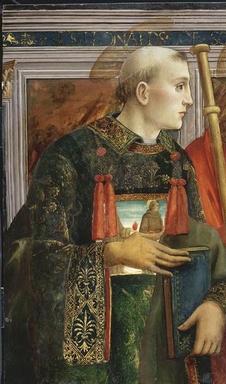St. Leonard of Limousin
 Nothing absolutely certain is known of his history, as his earliest “Life”, written in the eleventh century, has no historical value whatever. According to this extraordinary legend, Leonard belonged to a noble Frankish family of the time of King Clovis, and St. Remy of Reims was his godfather. After having secured from the king the release of a great number of prisoners, and refused episcopal honours which Clovis offered him, he entered a monastery at Micy near Orleans. Later he went to Aquitaine and there preached the Gospel. Having obtained, through prayer, a safe delivery for the Queen of the Franks in her confinement, he received as a gift from the king a domain at Noblac, near Limoges, where he founded a monastery. The veneration of this saint is as widely known as his history is obscure and uncertain.
Nothing absolutely certain is known of his history, as his earliest “Life”, written in the eleventh century, has no historical value whatever. According to this extraordinary legend, Leonard belonged to a noble Frankish family of the time of King Clovis, and St. Remy of Reims was his godfather. After having secured from the king the release of a great number of prisoners, and refused episcopal honours which Clovis offered him, he entered a monastery at Micy near Orleans. Later he went to Aquitaine and there preached the Gospel. Having obtained, through prayer, a safe delivery for the Queen of the Franks in her confinement, he received as a gift from the king a domain at Noblac, near Limoges, where he founded a monastery. The veneration of this saint is as widely known as his history is obscure and uncertain.
 It is true that there is no trace of it before the eleventh century, but from that time it spread everywhere, and little by little churches were dedicated to him, not only in France, but in all Western Europe, especially in England, Belgium, Spain, Italy, Switzerland, Germany, more particularly in Bavaria, and also in Bohemia, Poland, and other countries. Pilgrims, among them kings, princes, and high dignitaries of the Church, flocked to Noblac (now St. Leonard). Numerous miracles are attributed to him, and in one small town alone, Inchenhofen, Bavaria, from the fourteenth to the eighteenth century, there are records of about 4000 favours granted through his intercession. The saint wrought the delivery of captives, women in confinement, those possessed of an evil spirit, people and beasts afflicted with diseases. At the end of the eleventh century his name had already become renowned among the Crusaders captured by the Mussulmans. He is generally represented holding chains in his hands. His feast day is celebrated on 6 November.
It is true that there is no trace of it before the eleventh century, but from that time it spread everywhere, and little by little churches were dedicated to him, not only in France, but in all Western Europe, especially in England, Belgium, Spain, Italy, Switzerland, Germany, more particularly in Bavaria, and also in Bohemia, Poland, and other countries. Pilgrims, among them kings, princes, and high dignitaries of the Church, flocked to Noblac (now St. Leonard). Numerous miracles are attributed to him, and in one small town alone, Inchenhofen, Bavaria, from the fourteenth to the eighteenth century, there are records of about 4000 favours granted through his intercession. The saint wrought the delivery of captives, women in confinement, those possessed of an evil spirit, people and beasts afflicted with diseases. At the end of the eleventh century his name had already become renowned among the Crusaders captured by the Mussulmans. He is generally represented holding chains in his hands. His feast day is celebrated on 6 November.
PONCELET in Acta SS., November, III, 139-209; see also CHEVALIER, Bio-Bibl., s.v.
A. Poncelet (Catholic Encyclopedia)






